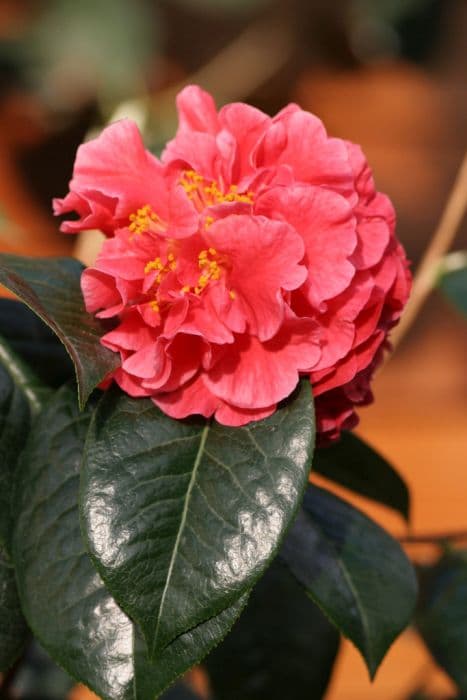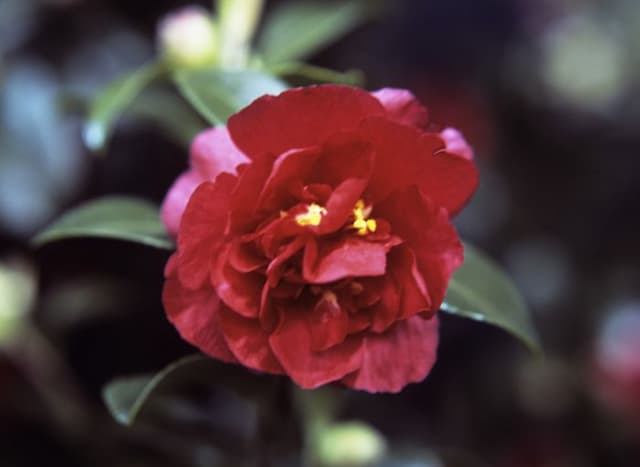Sasanqua Camellia Camellia sasanqua 'Winter's Snowman'

ABOUT
The Camellia sasanqua 'Winter's Snowman' is a variety of camellia that is admired for its exquisite flowers and glossy, dark green foliage. The elegant blooms are pure white, typically featuring a multitude of petals that create a full and rounded flower reminiscent of a snowball, which is quite fitting given its name. These blooms often display a central cluster of bright yellow stamens, adding a splash of color and contrast to the pristine white petals. The leaves of 'Winter's Snowman' are leathery in texture, with a smooth, shiny surface that reflects light, adding to the plant's overall luster. Its evergreen leaves maintain their rich color throughout the year, providing a beautiful backdrop for the seasonal blossoms. The growth habit tends to be dense and well-branched, forming a lush and compact appearance. Its flowering period typically falls in the cooler months, providing a striking visual interest when many other plants have ceased to bloom. Its graceful form and charming flowers make it a favorite among garden enthusiasts and an excellent choice for ornamental garden displays.
About this plant
 Names
NamesFamily
Theaceae
Synonyms
Sasanqua Camellia, Christmas Camellia, Autumn Camellia
Common names
Camellia sasanqua 'Winter's Snowman'.
 Toxicity
ToxicityTo humans
Camellia sasanqua, commonly known as Sasanqua camellia, is not considered toxic to humans. These plants are generally regarded as safe and there are no commonly reported symptoms of poisoning from ingesting parts of this plant. However, as with any non-food plant, it is always best to avoid ingesting it and to keep it out of the reach of children who might mistakenly consume plant parts.
To pets
Sasanqua camellia is also not considered toxic to pets. It is not known to cause any significant symptoms of poisoning in animals if they ingest parts of the plant. However, individual animals might have different reactions and some might experience mild gastrointestinal upset if they eat a large quantity of the plant material. It's still best to prevent pets from consuming the plant to avoid any potential issues.
 Characteristics
CharacteristicsLife cycle
Perennials
Foliage type
Evergreen
Color of leaves
Green
Flower color
White
Height
4-5 feet (1.2-1.5 meters)
Spread
4-5 feet (1.2-1.5 meters)
Plant type
Shrub
Hardiness zones
7-9
Native area
Japan
Benefits
 General Benefits
General Benefits- Ornamental Value: Camellia sasanqua 'Winter's Snowman' has beautiful white flowers that add aesthetic appeal to gardens during the fall and winter months.
- Long Blooming: This variety blooms over an extended period, often from fall into winter, providing color when many other plants are dormant.
- Privacy and Screening: With its dense growth habit, it can be used to create privacy hedges or screen unsightly views.
- Drought Tolerance: Once established, 'Winter's Snowman' is relatively drought-tolerant, making it suitable for regions with water scarcity.
- Low Maintenance: It requires minimal pruning and care once established, making it suitable for gardeners of all levels.
- Wildlife Attraction: The blossoms can attract pollinators, such as bees and butterflies, enhancing the biodiversity of the garden.
- Versatile Landscaping: Suitable for containers, borders, and as a specimen plant, offering flexibility in garden design.
- Cold Resistance: This plant is fairly cold hardy, allowing it to be grown in many temperate regions where frost may occur.
 Medical Properties
Medical PropertiesThis plant is not used for medical purposes.
 Air-purifying Qualities
Air-purifying QualitiesThis plant is not specifically known for air purifying qualities.
 Other Uses
Other Uses- Ink Production: The petals of the Camellia sasanqua can be used to create natural dyes for fabric, which can also be used to make a plant-based ink for art and calligraphy.
- Culinary Decoration: The flowers of the Camellia sasanqua are edible and can be used to decorate salads and desserts for an elegant touch.
- Scented Candles: The light fragrance of Camellia sasanqua flowers can be infused into candles to add a subtle, natural scent to a room.
- Handmade Paper: The petals and leaves can be incorporated into paper-making processes for creating textured and decorative paper products.
- Photography: The Camellia sasanqua, with its beautiful blooms, can be used as a subject or backdrop in macro and nature photography.
- Eco-printing: Leaves and petals can be used in eco-printing techniques to transfer their shapes and pigments onto fabrics or papers.
- Religious Ceremonies: In some cultures, Camellia sasanqua flowers can be used as offerings or decorations in various religious ceremonies.
- Bath Additive: Petals of the Camellia sasanqua can be added to bathwater for their fragrance and to create an experience of bathing in flowers.
- Aromatherapy: The essential oil extracted from the Camellia sasanqua can be used in diffusers and aromatherapy blends.
- Petal Confetti: Dried petals of the Camellia sasanqua can be used as natural, biodegradable confetti for celebrations such as weddings.
Interesting Facts
 Feng Shui
Feng ShuiThe Sasanqua Camellia is not used in Feng Shui practice.
 Zodiac Sign Compitability
Zodiac Sign CompitabilityThe Sasanqua Camellia is not used in astrology practice.
 Plant Symbolism
Plant Symbolism- Perfection and Excellence: As a cultivar of the Camellia, 'Winter's Snowman' carries the symbolism of perfection and excellence due to its beautiful blossoms and the high esteem in which Camellias are generally held, especially in Eastern cultures where they are often associated with the ideal.
- Admiration: The Camellia flower is a symbol of admiration and is often given as a gift to express one’s positive feelings toward another, recognizing their admirable qualities and achievements.
- Love: With its romantic and soft appearance, the Camellia is traditionally associated with love and affection. When given to a partner, it can convey deep emotional attachment and devotion.
- Longevity: Because of its evergreen nature and the durability of its petals, the Camellia symbolizes longevity and the endurance of life.
 Water
WaterFor the sasanqua camellia, watering should be thorough but not too frequent. It's important to keep the soil moist but not soggy. During the growing season, watering once a week with about 1.5 gallons of water per plant is adequate, depending on the size of the plant and the weather conditions. In hot, dry periods, you may need to water twice a week, whereas in cooler, wetter conditions, less frequent watering may be necessary. Always check the top few inches of soil for dryness before watering.
 Light
LightSasanqua camellias thrive in partial shade or filtered sunlight, making them suitable for an east or west-facing spot where they receive morning or late afternoon sun. Avoid full afternoon sun, especially in warmer climates, as it can cause leaf scorch. Bright, indirect light supports the best bloom production and plant health.
 Temperature
TemperatureSasanqua camellias prefer temperate climates and can tolerate temperatures as low as 10°F for brief periods. They are best suited to an environment where temperatures range from 60°F to 80°F. The ideal temperature for these plants to thrive is generally between 70°F and 75°F during the day, with cooler nights to encourage flower bud formation.
 Pruning
PruningPrune sasanqua camellias to maintain their shape and encourage bushier growth, as well as to remove any dead or diseased wood. The best time to prune is after they have finished blooming, typically in late winter or early spring. Thinning out crowded branches allows light and air to penetrate the plant, which helps prevent disease. Pruning every year or every other year is usually sufficient.
 Cleaning
CleaningAs needed
 Soil
SoilSasanqua Camellias require acidic, well-draining soil with a pH of 5.5 to 6.5. A mix of 1/3 pine bark, 1/3 garden soil, and 1/3 peat moss works well.
 Repotting
RepottingSasanqua Camellias should be repotted every 2-3 years; use a slightly larger pot each time to accommodate growth.
 Humidity & Misting
Humidity & MistingSasanqua Camellias thrive best in moderate to high humidity levels, ideally around 40-50%.
 Suitable locations
Suitable locationsIndoor
Place in bright, indirect light; keep soil moist.
Outdoor
Plant in partial shade or filtered sunlight; shelter from strong winds.
Hardiness zone
7-9 USDA.
 Life cycle
Life cycleCamellia sasanqua 'Winter's Snowman', commonly known as Sasanqua camellia, begins its lifecycle as a seed, which germinates in moist, well-drained soil under the right temperature conditions. Once the seedling emerges, it enters a juvenile vegetative stage, developing roots, stems, and leaves, a process that may take several years before it reaches maturity. As it matures, the plant undergoes a transition to the adult vegetative stage, marked by the growth of more substantial branches and the development of a robust foliage canopy. Upon reaching reproductive maturity, Sasanqua camellia enters a flowering phase, usually in the fall to winter months, producing white to pale pink fragrant blossoms that attract pollinators. Following pollination, the flowers form seed capsules which eventually open to release seeds, thus completing its reproductive cycle. The Sasanqua camellia can live for many years, even decades, continuing to grow and cycle through annual bloom seasons while contributing to environmental stability and diversity.
 Propogation
PropogationPropogation time
Early Spring
The Camellia sasanqua 'Winter's Snowman', commonly known as Sasanqua Camellia, can be effectively propagated through semi-hardwood cuttings mostly during late summer or fall when the plant's growth begins to slow. The most popular method entails selecting healthy, semi-hardwood stems that have matured after the current year’s growth. A cutting, usually about 4 to 6 inches long (10 to 15 centimeters), should be snipped just below a leaf node, and the lower leaves should be removed to expose a clean stem. The stem is then dipped in a rooting hormone to encourage root development and is planted in a well-draining potting mix. Maintaining a humid environment by covering the pot with a plastic bag or placing it in a greenhouse and keeping the soil consistently moist but not waterlogged assists in the rooting process. Rooting typically takes several weeks, after which the new plants can be gradually acclimated to less humid conditions before being transplanted into the garden.









